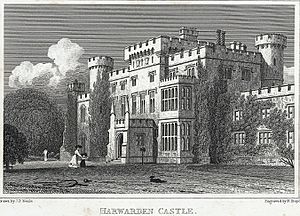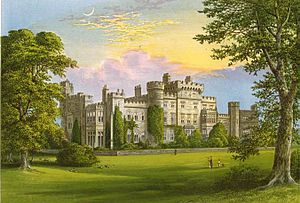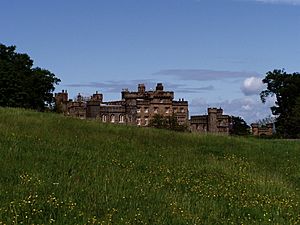Hawarden Castle (18th century) facts for kids
New Hawarden Castle (Welsh: Castell Penarlâg (Newydd)) is a large house in Hawarden, Flintshire, Wales. It was once the home of William Ewart Gladstone, who was a very important British prime minister. Before him, the house belonged to the family of his wife, Catherine Glynne. The house was first built in the middle of the 1700s. Later, it was made bigger and changed to look like a Gothic castle.
Contents
The Castle's Story
The main part of the house you see today was built between 1752 and 1757. It was designed for Sir John Glynne, a local landowner. This new house replaced an older building called Broadlane Hall. Sir John Glynne got the land through marriage. The first house was made of brick with stone details. It had three floors and many windows.
Changes Over Time
In the early 1800s, Sir Stephen Richard Glynne, 8th Baronet inherited the estate. Around 1809 to 1810, he made the house much larger. He also changed the outside to look like a crenellated (castle-like) Gothic Revival style. However, the rooms inside still kept their older Georgian style.
Later, Sir Stephen Glynne, 9th Baronet made more improvements. He was an important person in Flintshire and a Member of Parliament. Around 1830, he moved the main entrance of the house. He also added a grand, arched porch.
Gladstone's Home
After the 9th Baronet passed away, the house went to his brother-in-law, William Ewart Gladstone. Gladstone was a famous politician. He made more changes to the house. In the mid-1860s, a new wing was added to hold his large library. He also built a special room for his important papers in 1887–88. The porch was made even bigger in 1889.
Gladstone lived in the house until he died there in 1898. After his death, the house went to his grandson, William Glynne Charles Gladstone. Sadly, William Glynne Charles Gladstone was killed in the First World War. His uncle, Henry Gladstone, 1st Baron Gladstone of Hawarden, then bought the estate.
Today, New Hawarden Castle is still a private home. It is owned by the Gladstone family. Some parts of the grounds are open for people to visit.
The Old Medieval Castle
In the same grounds as New Hawarden Castle, you can find the ruins of a much older castle. This is Hawarden Castle. It was built by the Normans on the site of an even older Iron Age fort. It had a round tower (called a keep) on a large mound (a motte).
A Welsh prince named Llywelyn ap Gruffudd captured this old castle in 1265. He defeated the owner and destroyed the castle. The owner later rebuilt a stronger castle. This new castle was attacked again in 1281 by Llywelyn's brother, Dafydd. This led to a big war where the Welsh were defeated. After that, the English took over Hawarden Castle.
During the English Civil War, the old castle was fought over many times. It ended up being badly damaged and left in ruins.
Special Recognition
New Hawarden Castle is a very important building. It is listed as a Grade I building by Cadw. This is because of its beautiful architecture, especially the rooms from the 1700s. It is also important because it was the home of William Ewart Gladstone, a key figure in British history.





